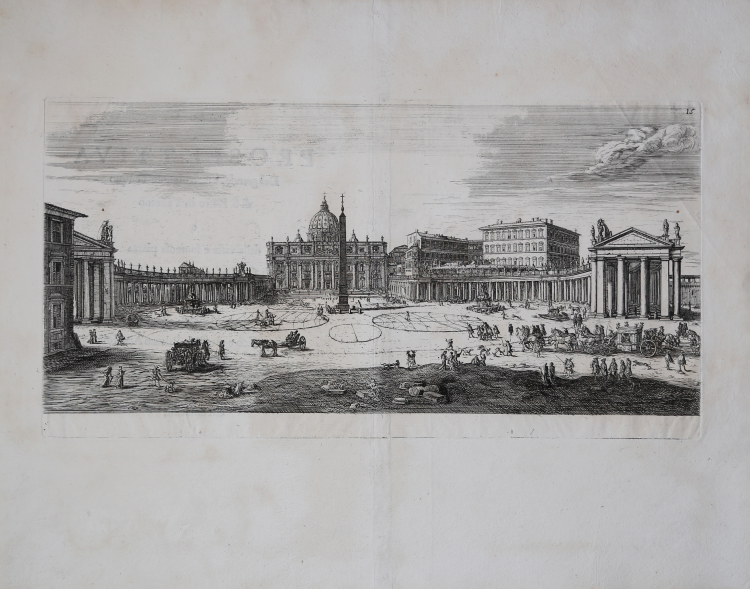- New




| Reference: | S52100 |
| Author | Gaspar Adriaensz van Wittel |
| Year: | 1678 ca. |
| Measures: | 445 x 230 mm |



| Reference: | S52100 |
| Author | Gaspar Adriaensz van Wittel |
| Year: | 1678 ca. |
| Measures: | 445 x 230 mm |
Etching, 1678 circa, signed at lower left Gasper van Wittel Fecit. After Cornelis Meijer.
Example of the second state of three, with the signature added and before the title Porspettiva della rinommata piazza e Guglia del Popolo.
The plate is part of Cornelis Meijer's "L'arte di restituire à Roma" (Rome: 1683).
Information about Gaspar Van Wittel (who Italianized his name to Gaspare Vanvitelli) is scant but suggests a rather unique education and outlook. We know he was born in Amersfoort, near Utrecht, in 1652 or 1653. At the tender age of twenty, van Wittel chose to travel to Italy, drawn primarily by the controversial allure of papal Rome, where he enthusiastically joined the vibrant community of the Bentvueghels and met Cornelius Meyer, an engineer engaged in hydraulic works on the Tiber in the Piazza del Popolo area. Meyer commissioned him to produce some technical drawings for his projects, and from then on, rigorous geometricism governed the perspectives of his views and the linearity of the buildings he depicted. From the Ponte Sisto to Piazza Navona, passing through Piazza del Popolo and Ripa Grande, the Quirinale, and Tiber Island, van Wittel portrays a working-class Rome, where the landscape juxtaposes the daily life of fishermen, boatmen, and street vendors. Curiously, van Wittel includes very cloudy skies in his paintings, more so than is usual in Rome, and it's conceivable that this "adaptation" contains a hint of nostalgia for Holland, certainly less sunny than Rome but rightly dear to him. Clouds aside, due to their candor, yet not devoid of elegance, these views were very successful and earned the artist numerous admirers and buyers, both among the Roman nobility and among foreign residents of the city, including Thomas Coke, who became one of his most important collectors.
A magnificent work, printed on contemporary laid paper, with wide margins and the usual vertical center fold. In excellent condition. Title in typeface printed on the verso.
Bibliografia
Hollstein, Dutch and Flemish etchings, engravings and woodcuts c.1450-1700, n. 3, II/III.
Gaspar Adriaensz van Wittel (Amersfoort 1653 – Roma 1736)
|
Dutch painter, draughtsman and etcher. Born in Amersfoort, and pupil of Matthias Withoos, in 1674 he moved in Rome, assisting the Dutch engineer and scientist Cornelis Maijer. In 1686 he became a member of the Congregazione dei Virtuosi al Pantheon. In 1688 married Anna Lorenzani (or Laurentini) in Rome and in 1709 he accorded the Roman citizenship. In 1711 confirmed as a member of the Accademia di San Luca in Rome. Between 1694 and 1710, he toured Italy and painted in Florence, Bologna, Ferrara, Venice, Milan, Piacenza and Naples. He is one of the principal painters of topographical views known as vedute.
His son Luigi would become a famous architect and also carries the italianized family name of Vanvitelli.
|
Gaspar Adriaensz van Wittel (Amersfoort 1653 – Roma 1736)
|
Dutch painter, draughtsman and etcher. Born in Amersfoort, and pupil of Matthias Withoos, in 1674 he moved in Rome, assisting the Dutch engineer and scientist Cornelis Maijer. In 1686 he became a member of the Congregazione dei Virtuosi al Pantheon. In 1688 married Anna Lorenzani (or Laurentini) in Rome and in 1709 he accorded the Roman citizenship. In 1711 confirmed as a member of the Accademia di San Luca in Rome. Between 1694 and 1710, he toured Italy and painted in Florence, Bologna, Ferrara, Venice, Milan, Piacenza and Naples. He is one of the principal painters of topographical views known as vedute.
His son Luigi would become a famous architect and also carries the italianized family name of Vanvitelli.
|